About Yoga Therapy
 Yoga therapy is a “narrowly focused” yoga, which synthesizes knowledge of modern medicine and physiology with ancient yogic knowledge about a person and is aimed at eliminating a particular disease / pathological condition – that is, yoga is used as a method of treatment. With the help of yoga exercises (asanas), breathing practices (pranayamas), purification practices (shatkarmas) – you can create a miracle to restore your body and health. All that is required is to have enough discipline to practice regularly. An hour and a half practice a day is, in my opinion, a good alternative to a scalpel or tablets, which usually “treat one and cripple the other” and have a temporary effect. Yoga therapy is a natural, natural way to restore health. Yoga therapy is literally an investment in your health and longevity. If you compare yoga and pills, it turns out that the more pills you eat, the less healthy you become. The more you do yoga, the more stable the healing effect, which only increases over the years. Moreover, yoga therapy is nevertheless a practice of yoga, which means that it leads to a greater understanding of one’s body, better contact with one’s true Self, expansion of consciousness.
Yoga therapy is a “narrowly focused” yoga, which synthesizes knowledge of modern medicine and physiology with ancient yogic knowledge about a person and is aimed at eliminating a particular disease / pathological condition – that is, yoga is used as a method of treatment. With the help of yoga exercises (asanas), breathing practices (pranayamas), purification practices (shatkarmas) – you can create a miracle to restore your body and health. All that is required is to have enough discipline to practice regularly. An hour and a half practice a day is, in my opinion, a good alternative to a scalpel or tablets, which usually “treat one and cripple the other” and have a temporary effect. Yoga therapy is a natural, natural way to restore health. Yoga therapy is literally an investment in your health and longevity. If you compare yoga and pills, it turns out that the more pills you eat, the less healthy you become. The more you do yoga, the more stable the healing effect, which only increases over the years. Moreover, yoga therapy is nevertheless a practice of yoga, which means that it leads to a greater understanding of one’s body, better contact with one’s true Self, expansion of consciousness.
It should be noted that yoga therapy is not a panacea, and there are cases when surgical and medical intervention is appropriate and necessary. Yoga therapist does not diagnose, only a qualified doctor can do this! Based on the diagnosis made by the doctor, the yoga therapist offers alternative methods of how you can try to work with a particular problem. It seems logical to me that, before radical intervention, a person will try all possible well-established natural methods of recovery. Naturally, we do not mean cases when a person’s life depends on the speed of radical intervention. Ideally, the work of a yoga therapist should go hand in hand with the work of a physician.
WHEN IS YOGA THERAPY RELEVANT?
First of all, yoga therapy is suitable for people with chronic diseases of the musculoskeletal system (for example, protrusion and hernia of the spine, flat feet, stoop),
With diseases of the cardiovascular system, hypertension, hypotension.
In chronic diseases of the respiratory tract and lungs: asthma, chronic bronchitis, etc.
In chronic diseases of the genitourinary, reproductive system: prostatitis, functional infertility in men and women, menstrual disorders, menopause.
In case of chronic digestive disorders
With endocrine disorders
Nervous system disorders
For environmental diseases
Immune disorders




